I was hanging at the top of a route, six feet above my last quick draw, left arm jammed past my elbow into a crack, left toe on a tiny nub of rock and nothing else stopping me from falling, falling, swinging, crashing.
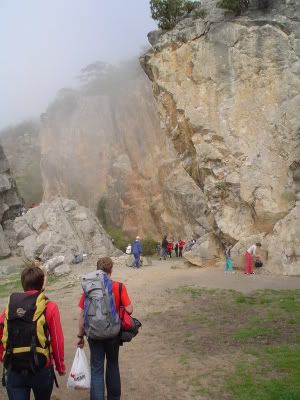
Coming upon the cliffs
I had been climbing for seven hours straight and had completed six routes, five of them on lead, all of them 5.10b's and 5.10c's. A 5.10 route, once considered the hardest climbs, are now only the bottom end of advanced climbing, but they're above the level of people who aren’t serious about the sport. Most of my early climbing was done in at a climbing gym in Oklahoma city, one built inside a huge grain silo. They didn’t use the numbering system for difficulty. Instead, easy was marked green, medium was marked blue and difficult was marked black.
I’d been on black all day.
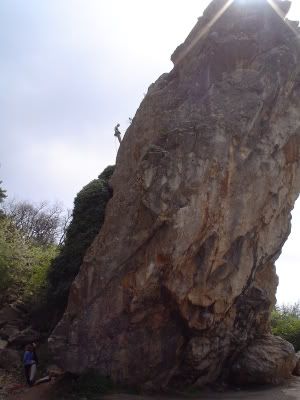
My friend, Dasha, working up to the top of a route called "Nuff-nuff"
A 5.10 route are the routes where you will be hanging by fingers, balanced on tiny toe holds or doing pull-ups and swinging a foot up to get past an overhang. They’re not 5.11s or 5.12s, where you do everything just mentioned but for the entire route, often at an acute backwards angle, but they’re still very difficult.
And, of course, there’s 5.13, which only the world’s best climbers can do, of which there was only one such route present at the cliffs in Crimea, a razor’s edge of featureless rock that required you to hang upside down by your fingers for most of it.
No one at the cliff went near it.
None of the people climbing around Jon and I were that good, but they were all damn good. Jon and I were puppies amongst the big dogs there, learning just how much we had to learn. We were, in two facing bluffs that stretched high before the Black Sea, in Ukraine’s rock climbing heaven.
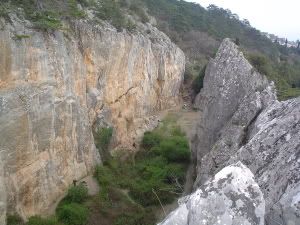
The cliffs
Jon still doesn’t trust his leading skills, which meant I had to lead almost all of the routes we did, wearing myself out in the process. Lead climbing is a giant evolutionary step from the top roping. When you top rope, the rope goes up from your harness to an anchor above you. Most people who have tried climbing have done top roping. If you fall on a top rope, you only fall a few inches. When you lead climb, though, the rope comes up from below and you clip it into bolts set into the rock as you go. Why lead climb? You have to: out on cliffs, no one is going to set a top rope for you. You have to lead up and set it yourself.
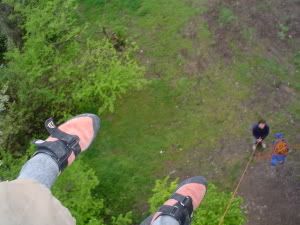
Sitting on top of a route called "Chimera". Jon is below
Lead climbing is more dangerous, though. If you are four feet above your clip, you will fall eight feet before you stop, swinging and slamming into the rock. The worst possible time to fall is right before you clip into your next bolt.
It can be a nerve wracking process: you reach a bolt and reach back and grab a quick draw-two carabineers attached by a short length of webbing--off your harness. You clip one carbineer into the anchor, then reach down to pull the rope to the other one. You are now at the worst part. You are holding on with one hand, feet precariously perched on whatever nub you can find, pulling up a rope which is being fed as fast as possible from below. Invariably you end up with slack, which means that if you miss clipping in and fall, you will fall that much farther.
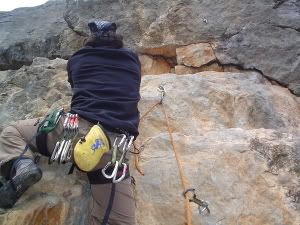
Here, you can see the basics of lead climbing: quick draws clipped into bolts and the rope. And you can also see my best side
The situation I was in was even worse: we were climbing on poorly formed limestone. Unlike the granite I’m used to, the rock had a surface like soap and my shoes could barely grip it. My hands were so tired from climbing all day that my fingers couldn’t stay clenched, which is why I shoved my arm into that crack. Now, if I fell, I’d be leaving a lot of skin behind.
I had thought I’d had strength left for one more route, a route called “Sim-Sim” as in “Sim, sim, Salabim!” what Aladdin yells to open the cavern. I jokingly said it before I started the route. The saying hadn’t helped: the route had started with a roof move, me hanging upside down and having to swing myself over an edge, grabbing a flake of rock with enough grip that I could pull myself over. That move took the last of my energy, but I was past the point of no return. The thing about lead climbing is that, if you don’t complete the route, you have to leave one of your quick draws on the wall so your partner can lower you down. Quick draws are only $18, but pride alone won’t let me leave gear on the wall. Besides, I only get paid $200 a month.
So I had to finish.
I kept working to the top of the route. If ever I found a crack big enough for my hand, I’d jam it in and rest for a bit. It wasn’t good for my hands, as my right one was already coated in chalk and blood.
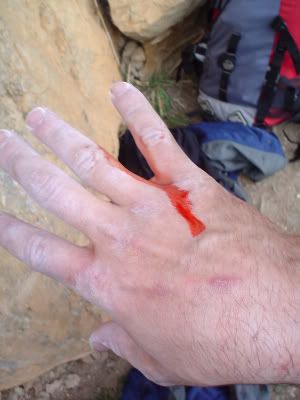
My poor hand,
Normally, climbing is just fun: feeling your body move in the warm sun up a rock face. Some days, like today, you just get in a push-yourself mood. Then it becomes the sport of masochists.
I did get up to the top, finally, to the top anchor which, luckily, was a drop-in: a big carabineer attached to the wall. Sometimes it’s just a ring, meaning you have to tie in with a piece of webbing, untie your rope, thread the rope through the ring, retie into the rope and then get lowered down. I didn’t really have the energy for that.
Lead climbing is taxing. It’s slower and you take more time between each move because you don’t want to fall. This means you spend a lot more time just gripping and looking at the wall for the best holds, time that tears up your muscles. And it’s mentally taxing. You’re focused every moment, planning, looking, feeling things through. Sometimes a minute can seem like an hour and an hour a minute.
The top anchor had a serious spring on it, which is why it didn’t move when I weakly pushed the rope at it and missed the clip, the rope falling out of my hand and down.
You learn a lot about yourself while climbing. One lesson is that you can always go farther than you think you can. My left side had started shaking. When you stand too long on a toe, your leg will start vibrating up and down. “Sewing machine leg”, they call it. Except now, my whole left side, arm jammed into the rock, toe on a nub, was trembling.
I only sort of dimly regarded it, though, because I simply knew one thing: falling would hurt a lot worse than the pain I was in now. At this point, it’d be a fall of fifteen feet, only slightly less than the height I fell from when I broke my leg. The rope would absorb some of the energy, but would swing me directly into the rock, a “face whipper” as climbers like to call it.
My hand came back up with the rope, smeared white and red. You learn things about yourself. Everyone has preprogrammed ideas of endurance that don’t give a real picture of how far your body can go, how much it can actually handle. Because as far as my conscious mind knew, I was out of energy, but my body, despite all the vibration, kept hanging on. Fuck it. I was not going to fall.
I shoved the rope through the clip and the gate swung back with a snap.
“Take!” I yelled, and Jon pulled all the slack out of the rope as I let go, forearm sliding out of the crack, feet leaving the rock and body dropping a few feet before just hanging.
I looked out. Fog had obscured the views the day before, but today, from the top of any given route, you could see over the trees, past the road, past the ramshackle houses and tiny farm plots on the hill side, and see the Black Sea.
Oh yeah, that’s why I do this.
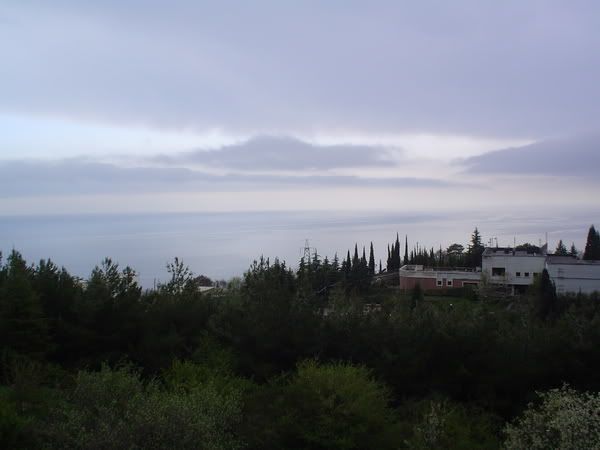
The Black Sea from the top of a route
My arms would hurt so bad the following night that the pain would keep me awake, but that was okay. I was a puppy running amongst the big dogs, and this is how I was going to get bigger.
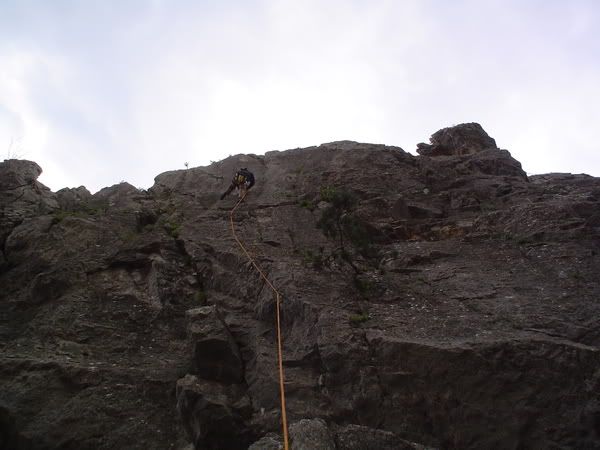
Me, climbing a route called "Kong"
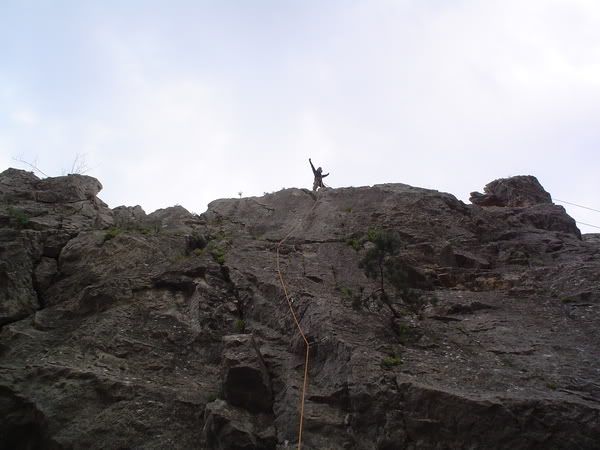
At the top
As I hung there, I thought about dinner and how good hot food would be. And we could watch Chappelle’s Show on Chandani’s laptop, and I could rest.
That’s what I thought about, along with a warm sense of accomplishment, as the adrenaline drained out and Jon lowered me to the ground.